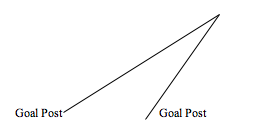by: John Van de Vaarst, National Director of Instruction, NISOA

John Van de Vaarst
Early in a referee career, everyone was taught that providing 10 yards to an offended team on a free kick was a right not a privilege. The only exception to this requirement is when a team elects to take a quick free kick and not wait for the opponents to retreat the 10 yards. Referees all learn these requirements at the beginning of their career. However, the enforcement of this requirement is vague at best. Many officials do not enforce the requirement early in the game. When it is late in the game and a critical situation it is difficult to change the behavior. Part of the enforcement problem is that referees may not know the rationale behind the 10 yard requirement. Knowing the logic of why a rule is in place makes it easier to apply the rule in a consistent basis. For the past several years at the NISOA National Training Academy Camp the participants attend an outdoor segment on the importance of a team being afforded 10 yards on a free kick. The method used is a string is tied to a goal post and extended out approximately 30 yards into the field and on an angle toward the touch line. The string is then looped around a nail and returned to the other goal post. Thus forming a large triangle. This is a diagram of the string.

One can readily see that the further the distance from the apex the larger the angle. If the apex represents the point of the foul and the placement of the ball, the further away the larger the angle. This equates to additional people in the wall to cover the entire goal from the free kick. If the wall was allowed to be set up at approximately 5 yards, it would only take 3 defenders to fill the triangle. Once it is set correctly at 10 yards, it takes 5 – 6 defenders to fill the area. Common sense clearly indicates if 6 individuals are in the wall, the same amount of attackers are not being marked and available for a pass from the free kick. This greatly assists the offence in a scoring opportunity and properly creates a burden on the defense who committed the foul. Also, if the wall is set up less than 10 yards away, the player taking the kick has a lesser amount of vision to release the ball for a shot or pass to a teammate. When the wall is at the proper location, the kicker can see a greater amount of the field and distribute the ball to a teammate or take a shot.
Now that the importance of 10 yards is clearly described, the next issue for the referee is knowing what is the proper measurement on the field for retreating a wall of defenders or located the proper location for a wall to set up. It is the job of the referee to ensure that where they decide the wall should be is 10 yards. As part of training, a referee should practice how to locate 10 yards and develop a method that makes it easy to establish the required distance. For example, one method is to run to a spot and point to it to inform the defending team that this is where the wall is to locate. For most referees, six or seven running strides equates to 10 yards. This approach sets the standard quickly with a minimum disruption to the flow of play. New referees are encouraged to practice and determine how many running steps it takes them to travel 10 yards. Knowing this will allow for the above suggested method to work smoothly.
When setting a wall on a “ceremonial” free kick it is most important to tell the kicking team that they cannot put the ball in play until there is a whistle. This prevents the ball from being put into play prior to the wall being set and the referee in proper position to observe the kick and subsequent play. One interesting thought – if the referee uses the whistle to move the wall, did the whistle sound to start play? It is suggested that the referee verbally move the wall and not use the whistle to it is time to resume play. This eliminates any possible confusion.
One exception to the 10 yard requirement is when there is an indirect free kick closer to the goal than 10 yards. In this instance the opponents may line up on the goal line between the goal posts to protect the goal. Any opponent not in this area must still be 10 yards from the ball. If the attacking team does not take a quick kick, the referee must make sure that the kick is not taken prior to all elements of the restart are satisfied. This will prevent dissent and other problems that will develop if the kick is executed prior to everyone is ready.
In summary, if the referee sets the wall and enforces 10 yards early in the game, there should not be difficulties late in the game or during critical situations.
